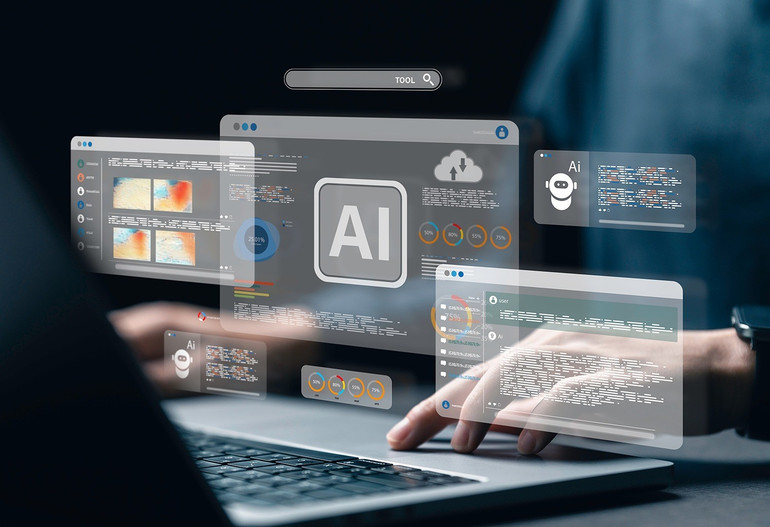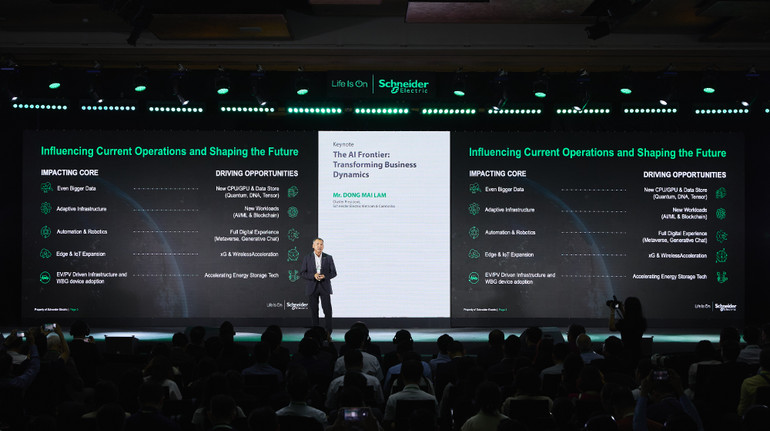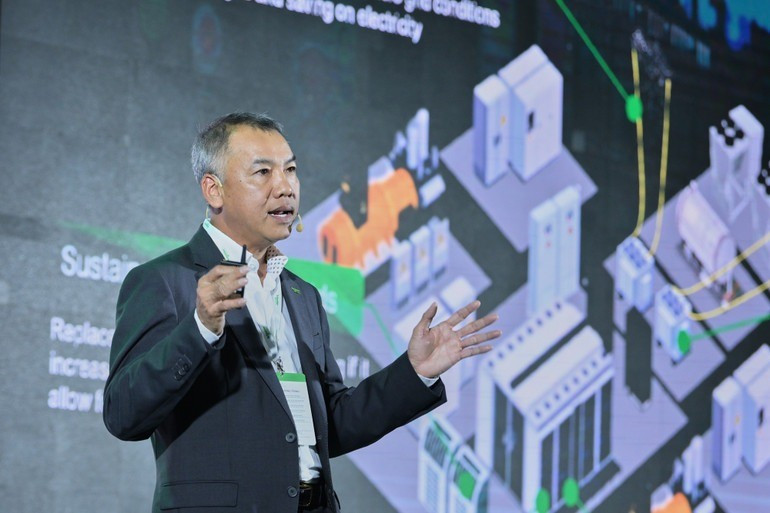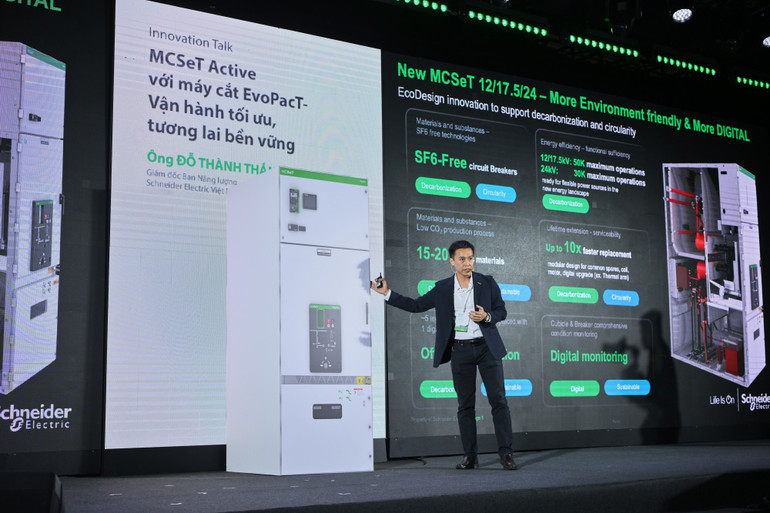
AI is reshaping data centers
In emerging markets such as Southeast Asia, especially Vietnam, artificial intelligence (AI) is emerging as a strategic pillar in the journey of digital transformation and national economic development.
According to forecasts, the AI market in Vietnam will grow by an average of 15.8% per year, reaching a scale of 1.52 billion USD by 2030. Furthermore, AI can contribute up to 130 billion USD to the Vietnamese economy by 2040.
AI is driving an unprecedented surge in demand for data. Data, in particular, is becoming a strategic asset, and domestic data storage, processing, and security are crucial in a volatile geopolitical landscape.
According to Deloitte's assessment, the total value of the AI market in Vietnam is forecast to reach 65 billion USD by 2035, distributed across three segments: application (30 billion USD), platform (10 billion USD) and infrastructure (25 billion USD). Although all three segments play an important role, the focus is currently shifting to the infrastructure segment, with the focus on data centers, creating a foundation that determines the AI readiness of each country and region.

Sharing at the recent Innovation Day Hanoi 2025 Conference, Mr. Dong Mai Lam, General Director of Schneider Electric Vietnam and Cambodia, commented that AI is completely changing the way infrastructure is designed, operated and optimized in general and data center infrastructure in particular.
Specifically, AI tasks are growing exponentially, requiring more powerful infrastructure than ever before. These infrastructures also require more energy. If in 2023, energy consumption for AI tasks and related infrastructure was only about 4.3GW, by 2028, this number is forecast to increase 3-4 times, reaching 13.5-18GW.
In terms of proportion, by 2028, AI could account for 15-20% of total data center electricity consumption, up significantly from 8% in 2023. This means that for every 5kWh used in a data center, 1kWh is dedicated to AI processing loads, requiring more efficient cooling systems and higher computing density than traditional IT systems.

At the same time, the data processing model is shifting from centralized to distributed, with about 50% of AI tasks expected to be processed in a hybrid model, which means combining data centers and edge processing, helping to increase processing speed and reduce latency. “This is the reason why to catch up with the AI wave, Vietnam needs a revolution in the way data centers are designed, built and operated,” Mr. Dong Mai Lam emphasized.
6 Trends That Have Changed and Are Changing AI Data Center Designs
According to the General Director of Schneider Electric Vietnam and Cambodia, there are 6 trends that have been changing in AI data centers in particular, and future data center designs in general.
First, data centers will become more interactive and optimized. Scheduling processing loads based on grid and microgrid conditions will not only help balance loads but also save significant energy costs.
Next, a sustainable dielectric liquid will gradually replace water in the cooling process. This technology helps improve heat dissipation efficiency, allowing for improved chip performance and reduced energy costs.
Another trend is the emergence of ultra-deep IT racks, which accommodate more complex server, network cable, plumbing, and PDU placement needs for high-density AI clusters.

In addition, the high temperature Chiller cooling system helps to optimize the design and operation of the refrigeration system with lower energy costs.
In addition, instead of distributing power at low voltage level, the medium voltage transformer is placed right in the technical space before the IT load. This helps to reduce the amount of copper material, reduce the conductors and shorten the installation time.
At the same time, AI-optimized rack PDUs will also change form factor, supporting more high-density servers while limiting the number of redundant sockets.
“All of these changes are aimed at building an efficient, sustainable data center infrastructure that is ready for growing AI workloads,” said Dong Mai Lam.
Flexible data center solutions adapt to fluctuations
Due to the surge in AI workloads, data centers are consuming a lot of resources, from electricity, cooling water to other resources. Meanwhile, the power grid in many places is having difficulty providing enough and stable power.
The above reality raises the problem of building a smart and sustainable energy strategy with advanced management software, capable of interacting with the grid and optimizing operations.
Schneider Electric provides a comprehensive solution for the entire lifecycle of a data center, from design and construction to operation and maintenance, integrating both hardware and software, optimally designed for different AI application needs.

At the design level, Schneider Electric provides sustainable data center solutions for AI, with tools such as ETAP, EcoStruxure IT Designer, EcoConsult services, as well as in-depth electrical system analysis studies. This is the foundation for data centers that are optimized for AI workloads from the start. Schneider Electric is now a partner with Nvidia to design AI data center infrastructure globally.
The next solution is a high-performance power system ready for AI, from low-voltage and medium-voltage switchgear and electrical cabinets, Galaxy 3-Phase UPS, to energy management solutions such as EcoStruxure Power Monitoring Expert, Power Operation... All to ensure stable, safe and reliable power flow for AI processing loads.
For cooling systems, Schneider Electric offers high-performance hybrid cooling solutions that combine air cooling with liquid cooling directly to the chip, flexible in each area of the data center. In addition, high-temperature chiller and free cooling solutions utilize ambient temperatures for natural cooling, helping to reduce power consumption.
In addition, to ensure safe and sustainable operations, Schneider Electric provides centralized management solutions AVEVA Unified Operations Center, cybersecurity services and software, and EcoCare after-sales support program. This is the layer of protection that gives customers peace of mind throughout the life cycle of data center operations.
“The above solutions all aim at a common goal: building an integrated, flexible data center infrastructure according to the scale and needs of each customer,” emphasized Mr. Dong Mai Lam - General Director of Schneider Electric Vietnam and Cambodia.
Source: https://nhandan.vn/xay-dung-ha-tang-trung-tam-du-lieu-linh-hoat-thong-minh-va-ben-vung-post910048.html


![[Photo] Prime Minister Pham Minh Chinh chairs the 14th meeting of the Steering Committee on IUU](https://vphoto.vietnam.vn/thumb/1200x675/vietnam/resource/IMAGE/2025/9/23/a5244e94b6dd49b3b52bbb92201c6986)
![[Photo] General Secretary To Lam meets voters in Hanoi city](https://vphoto.vietnam.vn/thumb/1200x675/vietnam/resource/IMAGE/2025/9/23/d3d496df306d42528b1efa01c19b9c1f)

![[Photo] Editor-in-Chief of Nhan Dan Newspaper Le Quoc Minh received the working delegation of Pasaxon Newspaper](https://vphoto.vietnam.vn/thumb/1200x675/vietnam/resource/IMAGE/2025/9/23/da79369d8d2849318c3fe8e792f4ce16)

![[Photo] The 1st Congress of Party Delegates of Central Party Agencies, term 2025-2030, held a preparatory session.](https://vphoto.vietnam.vn/thumb/1200x675/vietnam/resource/IMAGE/2025/9/23/e3a8d2fea79943178d836016d81b4981)





















































































Comment (0)